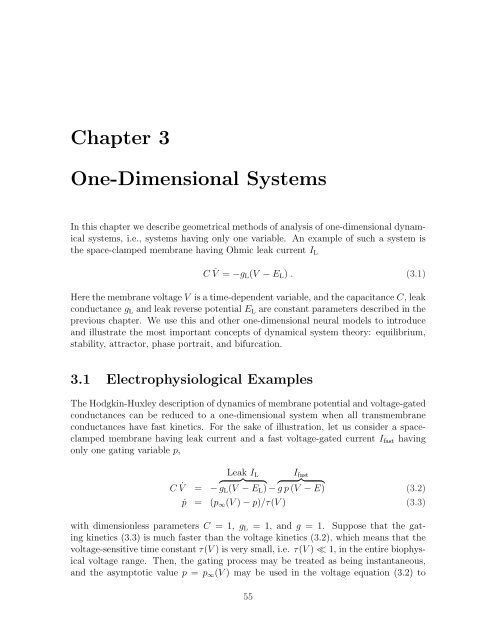Dynamical Systems in Neuroscience:
Dynamical Systems in Neuroscience: Dynamical Systems in Neuroscience:
54 Electrophysiology of Neurons
Chapter 3One-Dimensional SystemsIn this chapter we describe geometrical methods of analysis of one-dimensional dynamicalsystems, i.e., systems having only one variable. An example of such a system isthe space-clamped membrane having Ohmic leak current I LC ˙V = −g L (V − E L ) . (3.1)Here the membrane voltage V is a time-dependent variable, and the capacitance C, leakconductance g L and leak reverse potential E L are constant parameters described in theprevious chapter. We use this and other one-dimensional neural models to introduceand illustrate the most important concepts of dynamical system theory: equilibrium,stability, attractor, phase portrait, and bifurcation.3.1 Electrophysiological ExamplesThe Hodgkin-Huxley description of dynamics of membrane potential and voltage-gatedconductances can be reduced to a one-dimensional system when all transmembraneconductances have fast kinetics. For the sake of illustration, let us consider a spaceclampedmembrane having leak current and a fast voltage-gated current I fast havingonly one gating variable p,Leak I L IC ˙V{ }} { { }} fast{= − g L (V − E L ) − g p (V − E) (3.2)ṗ = (p ∞ (V ) − p)/τ(V ) (3.3)with dimensionless parameters C = 1, g L = 1, and g = 1. Suppose that the gatingkinetics (3.3) is much faster than the voltage kinetics (3.2), which means that thevoltage-sensitive time constant τ(V ) is very small, i.e. τ(V ) ≪ 1, in the entire biophysicalvoltage range. Then, the gating process may be treated as being instantaneous,and the asymptotic value p = p ∞ (V ) may be used in the voltage equation (3.2) to55
- Page 14 and 15: 4 Introduction(a)spikes(b)spikes cu
- Page 16 and 17: 6 Introduction1.1.3 Why are neurons
- Page 18 and 19: 8 Introductionconcepts of dynamical
- Page 20 and 21: 10 Introductionspikingmoderesting m
- Page 22 and 23: 12 Introduction(a)spikinglimitcycle
- Page 24 and 25: 14 Introductionco-existence of rest
- Page 26 and 27: 16 Introduction1.2.4 Neuro-computat
- Page 28 and 29: 18 IntroductionspikeFigure 1.16: Ph
- Page 30 and 31: 20 Introductionwith coupled neurons
- Page 32 and 33: 22 IntroductionFigure 1.17: John Ri
- Page 34 and 35: 24 Introduction
- Page 36 and 37: 26 Electrophysiology of NeuronsInsi
- Page 38 and 39: 28 Electrophysiology of Neuronsouts
- Page 40 and 41: 30 Electrophysiology of NeuronsRest
- Page 42 and 43: 32 Electrophysiology of NeuronsFigu
- Page 44 and 45: 34 Electrophysiology of Neuronsm (V
- Page 46 and 47: 36 Electrophysiology of Neurons10.8
- Page 48 and 49: 38 Electrophysiology of Neurons2.3
- Page 50 and 51: 40 Electrophysiology of NeuronsFigu
- Page 52 and 53: 42 Electrophysiology of NeuronsDepo
- Page 54 and 55: 44 Electrophysiology of NeuronsV(x,
- Page 56 and 57: 46 Electrophysiology of Neurons1m (
- Page 58 and 59: 48 Electrophysiology of NeuronsPara
- Page 60 and 61: 50 Electrophysiology of NeuronsFigu
- Page 62 and 63: 52 Electrophysiology of Neuronsvolt
- Page 66 and 67: 56 One-Dimensional SystemsActivatio
- Page 68 and 69: 58 One-Dimensional Systemsinwardcur
- Page 70 and 71: 60 One-Dimensional Systems40bistabi
- Page 72 and 73: 62 One-Dimensional Systemsat every
- Page 74 and 75: 64 One-Dimensional Systems?F(V)>0+
- Page 76 and 77: 66 One-Dimensional SystemsUnstableE
- Page 78 and 79: ¡ ¡ ¡¡ ¡ ¡¡ ¡ ¡¡ ¡ ¡¡
- Page 80 and 81: 70 One-Dimensional Systems+ - - + +
- Page 82 and 83: 72 One-Dimensional Systemsλ(V-Veq)
- Page 84 and 85: 74 One-Dimensional Systemsbifurcati
- Page 86 and 87: 76 One-Dimensional Systems100806040
- Page 88 and 89: 78 One-Dimensional Systemsbifurcati
- Page 90 and 91: 80 One-Dimensional Systems20 mV100
- Page 92 and 93: 82 One-Dimensional Systemsmembrane
- Page 94 and 95: 84 One-Dimensional Systemssteady-st
- Page 96 and 97: 86 One-Dimensional Systemsspike rig
- Page 98 and 99: 88 One-Dimensional SystemsVF (V)1VV
- Page 100 and 101: 90 One-Dimensional Systems10.80.60.
- Page 102 and 103: 92 One-Dimensional Systems
- Page 104 and 105: 94 Two-Dimensional SystemsI Na,pneu
- Page 106 and 107: 96 Two-Dimensional Systemsdefines a
- Page 108 and 109: 98 Two-Dimensional Systems(f(x(t),y
- Page 110 and 111: 100 Two-Dimensional Systems0.70acti
- Page 112 and 113: 102 Two-Dimensional Systems0.70.6K
Chapter 3One-Dimensional <strong>Systems</strong>In this chapter we describe geometrical methods of analysis of one-dimensional dynamicalsystems, i.e., systems hav<strong>in</strong>g only one variable. An example of such a system isthe space-clamped membrane hav<strong>in</strong>g Ohmic leak current I LC ˙V = −g L (V − E L ) . (3.1)Here the membrane voltage V is a time-dependent variable, and the capacitance C, leakconductance g L and leak reverse potential E L are constant parameters described <strong>in</strong> theprevious chapter. We use this and other one-dimensional neural models to <strong>in</strong>troduceand illustrate the most important concepts of dynamical system theory: equilibrium,stability, attractor, phase portrait, and bifurcation.3.1 Electrophysiological ExamplesThe Hodgk<strong>in</strong>-Huxley description of dynamics of membrane potential and voltage-gatedconductances can be reduced to a one-dimensional system when all transmembraneconductances have fast k<strong>in</strong>etics. For the sake of illustration, let us consider a spaceclampedmembrane hav<strong>in</strong>g leak current and a fast voltage-gated current I fast hav<strong>in</strong>gonly one gat<strong>in</strong>g variable p,Leak I L IC ˙V{ }} { { }} fast{= − g L (V − E L ) − g p (V − E) (3.2)ṗ = (p ∞ (V ) − p)/τ(V ) (3.3)with dimensionless parameters C = 1, g L = 1, and g = 1. Suppose that the gat<strong>in</strong>gk<strong>in</strong>etics (3.3) is much faster than the voltage k<strong>in</strong>etics (3.2), which means that thevoltage-sensitive time constant τ(V ) is very small, i.e. τ(V ) ≪ 1, <strong>in</strong> the entire biophysicalvoltage range. Then, the gat<strong>in</strong>g process may be treated as be<strong>in</strong>g <strong>in</strong>stantaneous,and the asymptotic value p = p ∞ (V ) may be used <strong>in</strong> the voltage equation (3.2) to55



